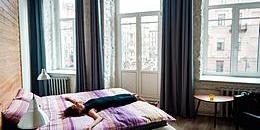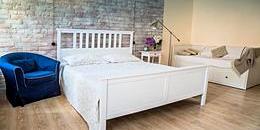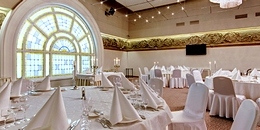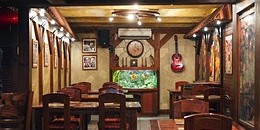Liteyny Prospekt
One of the main avenues of St. Petersburg, running perpendicular to Nevsky Prospekt, Liteyny Prospekt was laid out in the very earliest years of the city's existence. It was the location of the foundry workshops charged with casting the first canon for the new Russian navy. Later, the street became home to a few luxurious estates, as well as numerous interesting residential buildings and shops.

At the very beginning of the 18th century, the foundry yard ("Liteyny dvor") was established on the left bank of the Neva River. To connect it to Nevsky Prospekt, a wide strip was cleared, which later gained the name "Foundry Avenue". Gradually, the surrounding area was occupied by various workshops and built up with wooden houses. The landmarks of the area became two Russian Orthodox churches: The Church of St. Panteleimon the Healer and the Transfiguration Cathedral, which were constructed about 600m apart, and both facing towards Liteyny Prospekt, providing a stunningly beautiful panorama.

There was little further change to Liteyny Prospekt until the middle of the 19th century, when an order was issued forbidding the construction of wooden buildings, and demanding that existing wooden buildings be replaced with stone. Over the next 40 years, Liteyny experienced a real construction boom. Among the first major projects to appear were the mansion of Grand Princess Dolgorukova, the house of the Musin-Pushkin family, and the barracks of the Life Guard's Artillery. Around the same time, Liteyny Prospekt was extended right up to the Neva, where there was a floating wooden bridge. Soon, the avenue gained a reputation as a fashionable neighborhood, and a number of famous stores were established there. In the second half of the 19th century, Liteyny Prospekt saw the construction of the palace of Countess Zinaida Yusupova, the Kraevsky Apartment Building, the Officers' Assembly Building, and the house of "the millionaire and Byzantine prince" Muruzi. In 1913, construction of the Novy Passazh shoppintg arcade was completed.

After the October Revolution, Liteyny Prospekt bore the name of the revolutionary Volodarsky until 1944. The apartment-museum of Nikolay Nekrasov was opened, and nearby a monument to the great popular poet was unveiled. It should be added that, in the mid-19th century, not only Nekrasov but also the satirist Mikhail Saltykov-Shchedrin lived on Liteyny, and they were visited by Ivan Turgenev, Fyodr Dostoevsky, Aleksey Ostrovsky and Nikolay Chernyshevsky, among others. This tradition of Russian literary greats was continued in the 20th century by Joseph Brodsky, who lived in the Muruzi House, and before him by his mentor, the great Anna Akhmatova, whose popular museum is located in one of the apartments where she lived in the Sheremetev Palace (the Fountain House), between Liteyny Prospekt and the Fontanka River.

A less palatable aspect of the avenue's history is connected with the so-called "Big House" (Bolshoy dom) - the local headquarters of the NKVD (later the KGB and now the FSB). Built on the site of a regional court building burnt down in 1932, this monumental late constructivist building architecturally interesting, but indelibly stained by the torture, abuse, and murder carried out there during Stalin's reign.
Today, Liteyny Prospekt is one of St. Petersburg's main through roads, as well as a popular route for tourists, taking them through an area rich in architectural landmarks, museums and shops.
| Metro stations: | Chernyshevskaya, Mayakovskaya |
|---|---|
| Best walking route: | The whole avenue (1.9km) |
| What's here? | Mansion of Grand Princess Dolgorukova, Musin-Pushkin House, Life Guard Artillery Barracks, Palace of Countess Yusupov, Kraevsky Apartment Building / Nikolay Nekrasov Memorial Apartment-Museum, Officers' Assembly, Novy Passazh, KGB Building, Muruzi House, Mariinskaya Hospital |
| What's nearby? | Liteyny Bridge, Kutuzov Embankment (Naberezhnaya Kutuzova), Robespierre Embankment (Naberezhnaya Robespera), Shpalernaya Ulitsa, Ulitsa Pestelya, Transfiguration (Spaso-Preobrazhensky) Cathedral, Nevsky Prospekt, Vladimirsky Prospekt, Sheremetev Palace (Fountain House), |












